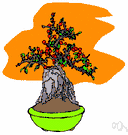Cotoneaster horizontalis
Also found in: Thesaurus, Wikipedia.
ThesaurusAntonymsRelated WordsSynonymsLegend:
Switch to new thesaurus
| Noun | 1. |  Cotoneaster horizontalis - deciduous flat-growing shrub with a fanned herringbone pattern and having reddish flowers and orange-red berries; used as a ground cover Cotoneaster horizontalis - deciduous flat-growing shrub with a fanned herringbone pattern and having reddish flowers and orange-red berries; used as a ground covercotoneaster - any shrub of the genus Cotoneaster: erect or creeping shrubs having richly colored autumn foliage and many small white to pinkish flowers followed by tiny red or black fruits |
Based on WordNet 3.0, Farlex clipart collection. © 2003-2012 Princeton University, Farlex Inc.